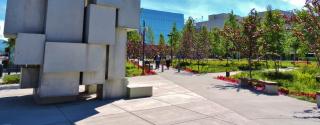Combine large mountains and coastline with fields of wildflowers, add in a moose cow and calf, and you have a scenic spectacle that can only be seen in Alaska! From shooting stars to lupine to fireweed, the show is continuous and evolving from June through August and Anchorage is ideally located to take in this annual event. Most cell phones are more than adequate to photograph these amazing flowers, but even better are 35mm cameras equipped with wide-angle and macro lenses. Consider purchasing one of the colorful, Alaska wildflower field guides for plant identification. Lastly, when venturing into Alaska’s backcountry, don’t forget to wear sturdy shoes, and consider bringing hiking poles, binoculars, bear spray and most importantly, a sense of wonder!

Early Alpines – Early to mid-June
After a long, snowy winter like in 2023/24, May temperatures and snowmelt will determine the onset of the wildflower season. The high alpine meadows are windblown in winter and often have less snow to melt in spring, bringing them the earliest of the blooming wildflowers. Road accessible areas like Glen Alps (Chugach State Park), the top of Arctic Valley, and the high meadows above the Seward Highway in Turnagain Arm start the season off on their south facing slopes in June. Rocky, alpine plateaus are covered in mounds of multiple colors with the rich pinks of Alpine Azalea (Louseleuria procumbens), Purple Mountain Saxifrage (Saxifraga oppositifolia), Moss Campion (Silene acaulis), and Wooly Lousewort (Pedicularis Kanei). The brilliant yellow Ross Avens (Geum Rossii) and the blue Alpine Forget-me-nots (Myostis asiatica, also the State wildflower) add accent color. The cheerful patches of white round out the early show with Mountain Avens (Dryas octopetala), Arctic Sandwort (Minuaria arctica), anemones and saxifrages. If you are lucky, you can catch Arctic Ground Squirrels gathering the wildflowers and grasses to line their burrows making beds for new young.
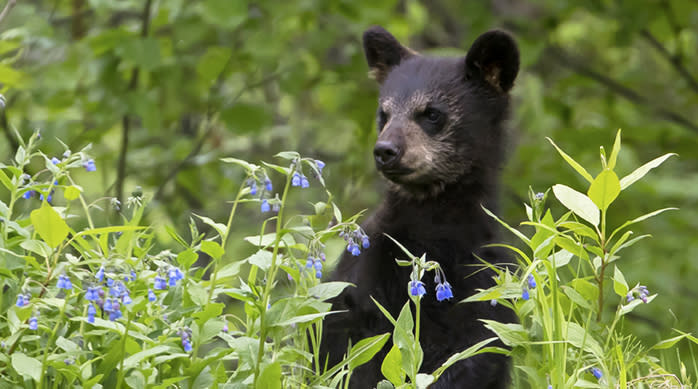
Lupine – Mid- to late June
The lower coast along Turnagain Arm and Cook Inlet soon joins the show in mid- to late June. Turnagain Arm south to Portage is famous for its fields of magenta-blue Lupine (Lupinus spp.) lining the railroad tracks and Seward Highway. Yet a walk along any of the coastal trails yield a diverse bouquet of Wild Geranium (Geranium erianthum), Wild Roses (Rosa nutkana), Coastal Paintbrush (Castilleja unalaschensis), Bluebells (Mertensia paniculata), Wild Iris (Iris setosa), Tall Jacobs Ladders (Polemonium caeruleum), Shooting Stars (Primula frigidum), Chocolate Lilies (Fritillaria camschatcensis), and Western Columbine (Aquilegia Formosa). Moose start to calve in mid-May, but are more visible in June as the calves grow and are more able to travel. The lush, tender wildflower greens are a feast for the new moose families, providing human visitors some uniquely Alaskan, photographic opportunities. In addition, Black Bears wander these same areas teaching their cubs to eat the fresh greens. Bode care in traveling these wild coastal trails, but yet savor the opportunity to visit this lush oasis between the towering mountains and the sea.
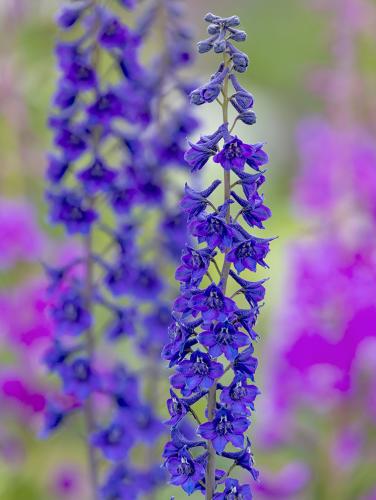
Wild Orchids – All Summer
Surprising to many visitors, Alaska is home to over 30 species of wild orchids! The Spotted Lady’s Slipper (Cypripedium guttatum) - one of the largest and showiest of Alaska’s orchids, can be found in the Anchorage area in early summer, but is not common. The white spikes of Bog Candles (Platanthera dilatata) are likely the most commonly sighted Alaska orchid, residing in coastal wet, open areas and blooming all summer long. My personal favorite is the Calypso Orchid or Fairy Slipper (Calypso bulbosa), which blooms in open, wet areas, a bit earlier (early June) than the other orchids.
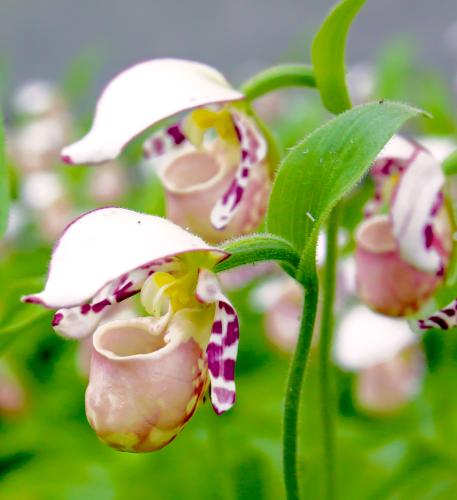
Dwarf River Beauty – July
Many of these wildflowers continue to bloom well into July, as the snow on the mountains’ north faces and valleys finally give way to the summer rush to grow and reproduce. Aptly named, the hot pink, Dwarf River Beauty (Chamerion latifolium) blankets the rocky banks of the glacial rivers feeding into the glacially-formed lakes. Venturing along the trails around Portage Lake, Eagle River, and above Eklutna Lake provide jaw-dropping mountain scenery, highlighted by these abundant pink flowers. Goatsbeard (Aruncus dioicus) adds a taller white, fluffy accent, thriving along the open edges of boreal forest south of Anchorage, and catching your eye along the roadways.
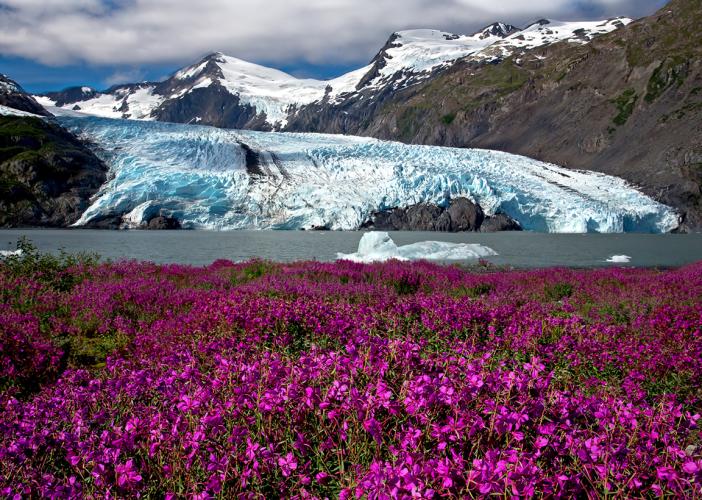
Fireweed – Late July through mid-August
Perhaps the Fireweed (Chamerion angustifolium) is the best known and most photographed wildflower in Alaska. As a pioneer plant species, Fireweed got its name for emerging soon after large wild fires, and blanketing the blackened scenery with fields of tall, pink flowers. Being able to pioneer, the Fireweed also quickly colonize roadsides and any disturbed areas, making it a highlight of Anchorage’s vast network of city trails. The first blooming Fireweed is usually sighted in mid-July, and flowering generally peaks in Southcentral Alaska in early to mid-August. Moose also love Fireweed, using their teeth to strip the stems of their flowers. Local beekeepers delight in having their bees produce the light-colored fireweed/wildflower honey, nicknamed “liquid gold” for its unique flavor bouquet and high value among honey connoisseurs. Watch for fresh, local honey in the farmer’s markets starting in August.

Late July into August brings a cast of new players in the wildflower scene, who generally have to be taller to compete with the grasses. Wild Larkspur (Delphinium glaucum), Monkshood (Aconitum delphinium), False Hellebore (Veratum viride), Sitka Burnet (Sanguisorba stipulata), Cow Parsnip (Heracleum lanatum), Wild Goldenrod (Solidago simplex) and Siberian Aster (Aster sibericus) continue the wildflower show along the local trails.
Wildflowers sometimes take backseat in the minds of visitors and locals alike starting in late July, due to the ripening of Alaska’s wild berries. Blueberries (Vaccinium spp.) are king, not to be out done by tall salmon berries (Rubus spectabilis), crowberries (Empetrum nigrum), serviceberries (Amelanchier florida), wild red currants (Ribes triste), highbush cranberries (Viburnum edule), and lastly in early fall by lowbush cranberries (Vaccinium vitis). Fields of wild berries can be just as photogenic as wildflowers, but sometimes it is hard to get those mountain views without being photo-bombed by berry pickers - mostly human, occasionally bear.
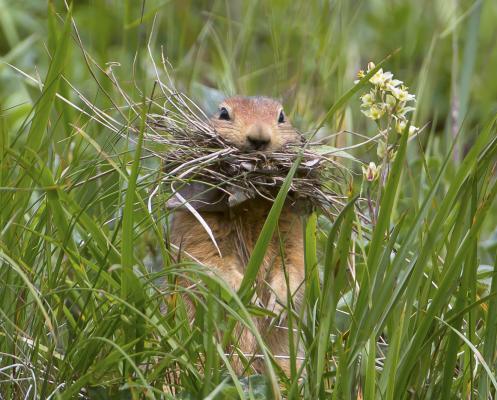
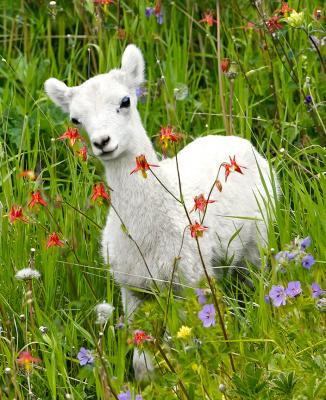
Around the time of the Alaska State Fair in Palmer, the Fireweed bloom progression reaches the tops of their stems, and fresh snow (“Termination Dust”) appears on the mountain peaks. Local residents know the wildflowers, berry picking, and the summer are all reaching their ends. Yet in early September, Fireweed offers a “second bloom” of brilliant red, autumn foliage that paints the mountainsides fire red, heralding the “leaf peeper” season for Alaska visitors, but that’s another story…
Anchorage —City of Flowers
Anchorage is ideally located as a hub for wildflower day trips in all directions. Yet the Anchorage municipality itself (from Portage through Eklutna), also takes pride on being a vibrant showcase of hanging baskets, and impressive, colorful beds of annual flowers maintained by the city. The Alaska Botanical Garden, located in Anchorage, is the place to view and learn about both the local wildflowers and the botanical wonders that Alaska’s gardeners cherish. Even Anchorage’s local master gardeners occasionally open up their private sanctuaries for scheduled, public tours in the summer.
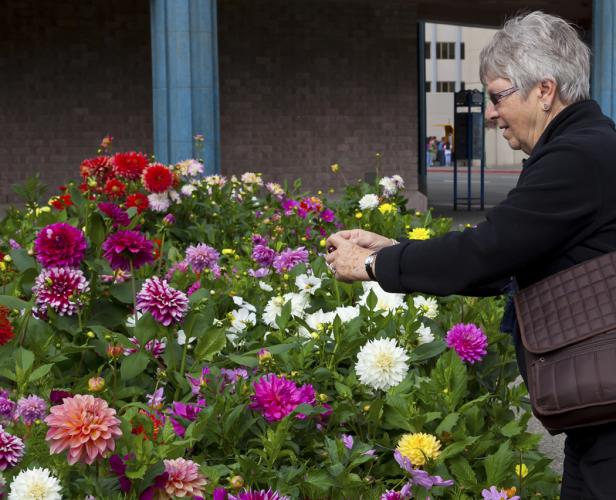
Those seeking even more information on area wildflowers, local programs and wildflower walks can visit the websites of the Wildflower Garden Club of Alaska (www.wildflowergardenclub.org) and the Alaska Native Plant Society (www.aknps.org).
Donna Dewhurst, Retired Wildlife Biologist/Photographer/Master Gardener
Go to Flowers in Anchorage >
Donna Dewhurst
Donna Dewhurst, Retired Wildlife Biologist/Photographer/36-year Alaska resident

